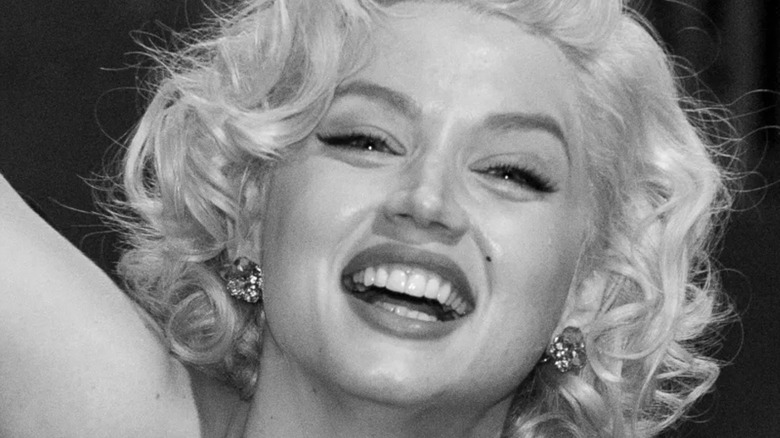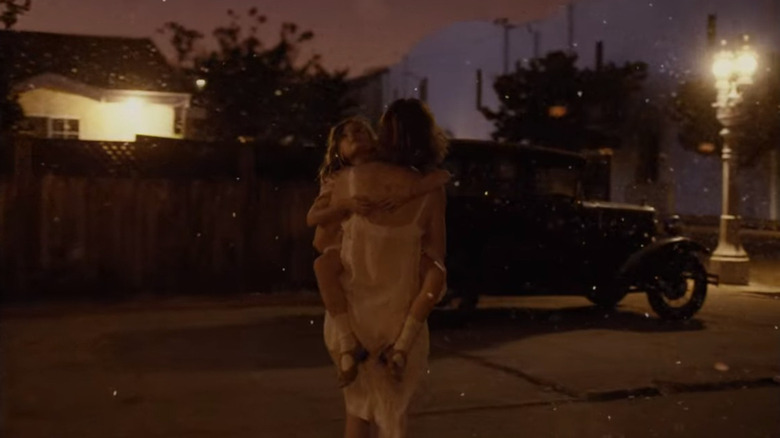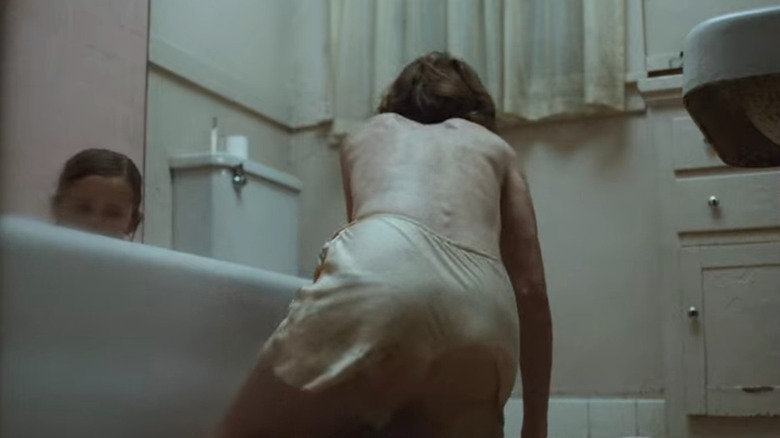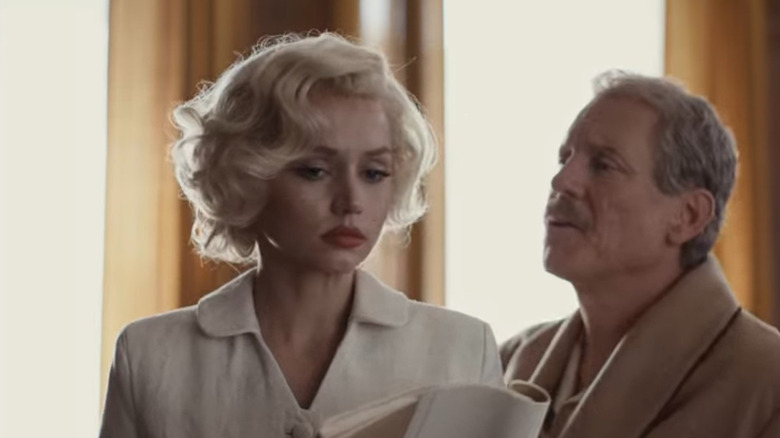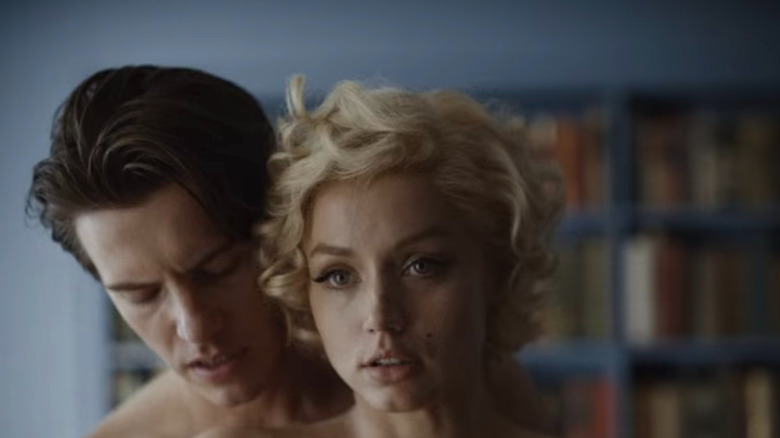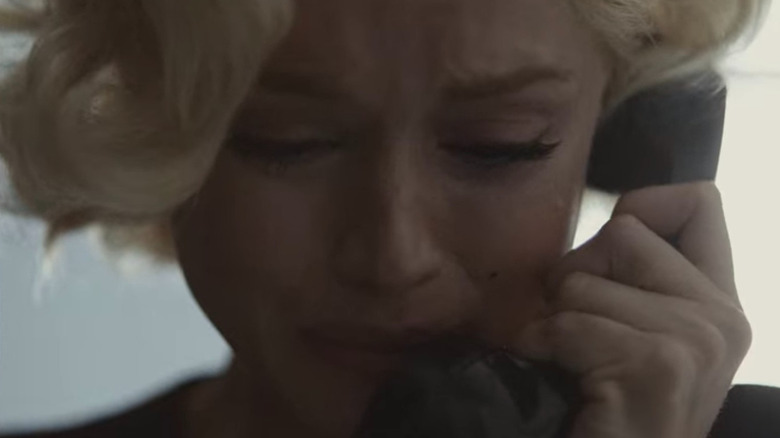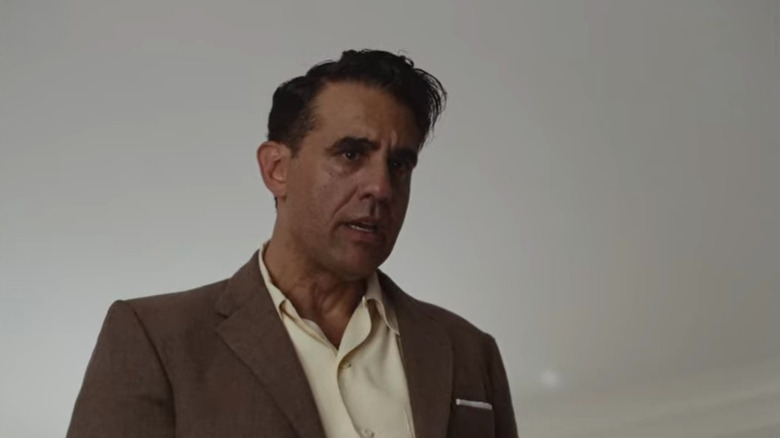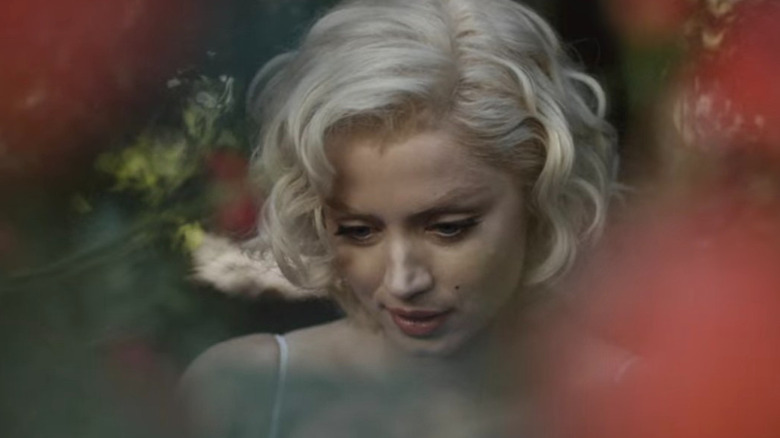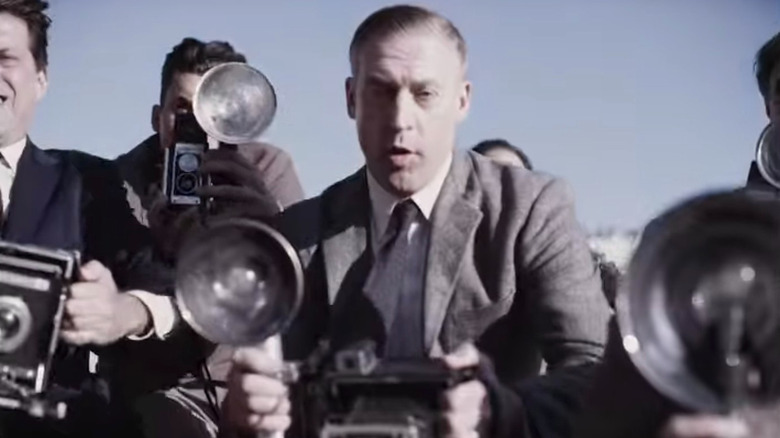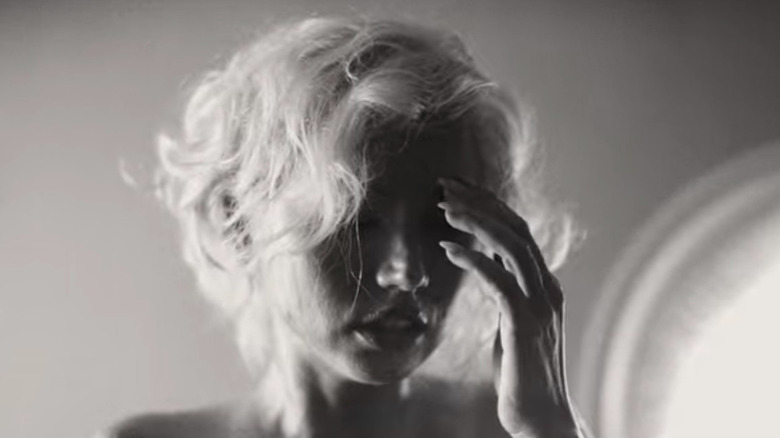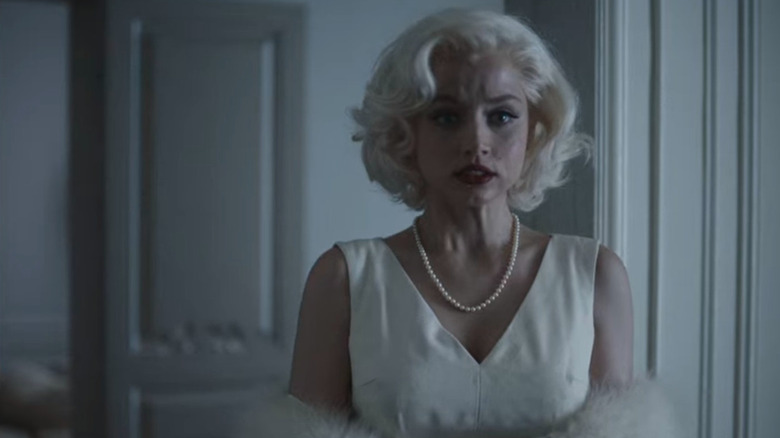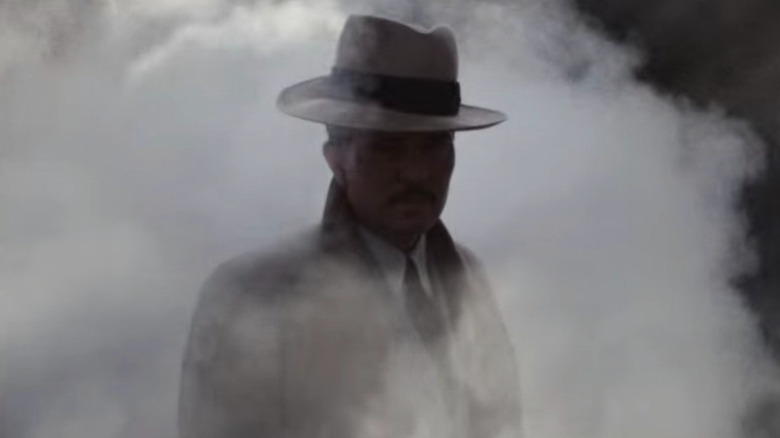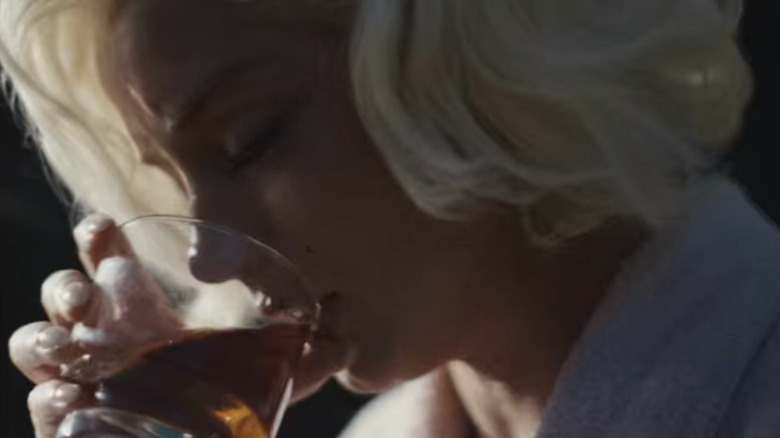Blonde Moments That Really Upset Fans The Most
Due to the nature of the movie, the following article contains instances of drug and alcohol abuse, self-harm and suicidal ideation, domestic violence, child abuse, and sexual assault.
Even in death, Marilyn Monroe can't escape exploitation and sexualization from her "admirers." Sometimes, fame comes with a price tag. In Monroe's case, that price was not only her life, but often her dignity and sense of self. Everyone wanted a piece of Monroe — studio execs, paparazzi, rabid fans, and even her husbands. Her tumultuous upbringing with an absent father and an unstable mother left Monroe endlessly on the search for love, yet she only seemed to find abuse.
Monroe turned to self-medication with alcohol and drugs to dull the sting of untreated mental health concerns and a life spiraling out of control. She toggled between what society expected from her and who she was in her heart. This proved too much for the actress — and the very fans and industry that caused her death mourned her. But the world isn't done making a spectacle of Monroe.
Based on Joyce Carol Oates' book by the same name, the NC-17 Netflix film "Blonde" takes every opportunity to sexualize and graphically depict the worst moments of Monroe's life. Not only does the movie take its most disturbing scenes way too far, but the creative liberties and warped history are also heavily dramatized and even fabricated. Ana de Armas is breathtakingly heartbreaking as Monroe, but the movie's treatment of her in these upsetting scenes is the biggest takeaway.
A blaze of trauma
It doesn't take long before "Blonde" sets the tone for the horrors graphically depicted later in the film. In a flashback montage, Marilyn's mother Gladys flees with her daughter in the midst of a raging Los Angeles fire. But she doesn't take Marilyn away from the blaze — she drives her straight into them. As flames engulf the area surrounding the Hollywood sign, the sinister metaphor hints at how this industry won't provide Marilyn an escape from her problems, but rather a different kind of hell.
An officer is troubled by Gladys' behavior when she drives far enough to enter a police blockade. Yet, despite numerous glaring red flags, he forces a clearly unstable woman to drive off with her young daughter in the middle of a manic episode.
In a shocking moment, Gladys snaps and starts brutally beating her daughter. Not only does the moment further stigmatize mental illness as a violent condition, but the scene isn't something we need to see onscreen. There are ways to allude to child abuse without making viewers witness the brutality themselves.
If you or anyone you know is having suicidal thoughts, please call the National Suicide Prevention Lifeline by dialing 988 or by calling 1-800-273-TALK (8255).
Mother doesn't know best
If fans thought the onscreen beating sequence was rough, it's nothing compared to what happens in the bathtub. During what appears to be another manic episode, Gladys viciously tries to drown young Marilyn in a steaming hot bathtub. Beyond the shock of depicting this scene so extensively onscreen, it's beyond disturbing that Gladys carries out the rampage shirtless, and young Marilyn is completely naked.
It's bad enough that Monroe herself had to endure so much abuse. But with a film literally chronicling the predatory nature of Hollywood, it's baffling that director Andrew Dominik would put a young actress through a scene like this where she's completely exposed and vulnerable while dealing with content that no child should be subjected to.
It seems in terrible taste to potentially traumatize a child for a scene that's absolutely unnecessary to film in this manner. To make matters worse, Marilyn runs around the apartment complex without so much as a towel on, further adding to the exploitative factor. The intent is to show the gravity of the situation, which is valid, but there are more tactful ways to tell these kinds of stories.
If you or someone you know may be the victim of child abuse, please contact the Childhelp National Child Abuse Hotline at 1-800-4-A-Child (1-800-422-4453) or contact their live chat services.
An exploitative industry
It's no secret that Hollywood can be extremely predatory, and was even more so in the '40s, when there were few efforts to curb sexual assault. To illustrate the seedy underbelly of Hollywood, where women would often have to exchange sexual favors for roles, we watch in horror as a studio big wig rapes Marilyn.
We're forced to watch as Mr. Z pulls Marilyn's underwear down, thrusting offscreen while she cries. At what point does something intended to shine a light on an issue make the problem worse? This scene is utterly traumatizing for anyone who's endured sexual advances or assaults they couldn't speak out against.
As the door closes, we see a "President" plaque adorned on the wood. During the '40s, Darryl F. Zanuck was a higher-up at 20th Century Fox: Monroe's long-time employer. Though Zanuck wasn't president, is this a coincidence? Unlikely. Zanuck's alleged sexual abuse infamy was so well-known that there were allegedly tunnels from his office so that women could come and go without being seen (via Deadline). So, once again, the movie gives an abundance of power to a real predator.
If you or anyone you know has been a victim of sexual assault, help is available. Visit the Rape, Abuse & Incest National Network website or contact RAINN's National Helpline at 1-800-656-HOPE (4673).
A coerced three-way
Marilyn's onscreen relationship with Cass Chaplin (Charlie Chaplin Jr.) and Edward G. Robinson Jr. certainly isn't the most problematic aspect of the film, but it starts out too forceful for comfort. The duo begins taking their clothes off, and Cass even acknowledges Marilyn's discomfort by calling her a prude. Instead of respecting her unspoken boundaries, they push forward, and the audience witnesses another pointlessly shirtless Marilyn scene within an imbalanced power dynamic.
In some ways, her relationship with Cass and Eddy is worse than the other tumultuous affairs. Unlike most of the graphic scenes in the movie, this one is romanticized, and fans are clearly meant to root for this trio. Marilyn develops a trusting and loving relationship with both men that carries through the rest of their onscreen lives, and even through her marriages.
What's more? According to Vanity Fair, there's no evidence to suggest that such a relationship occurred. There's evidence alluding to Monroe having an affair with the men separately, but not the three of them together. So, instead of focusing on her real-life destructive relationships, the film spends significant time and energy centering Monroe's love life around two possible flings — all while romanticizing a pretty toxic dynamic.
The forced abortion
Marilyn makes a decision a third of the way through the film, and it's one that viewers won't be able to forget. Fearful of passing mental illness onto her fetus, Marilyn opts to obtain an abortion — with some "encouragement" from the studio. But things quickly get disturbing. Though there's no evidence that the studio forced Monroe into an abortion, or that she had one of her own volition (via The Cinemaholic), Monroe's onscreen counterpart regrets her decision and tries to leave — all to no avail.
The scene is straight out of a horror movie as Marilyn screams and fights back against the doctors, making her go through with the procedure. According to Vanity Fair, Will Harrison Hays (of Hays Production Code fame) used his political expertise for a sinister cause: Forcing Hollywood stars who break morality clauses in their contracts to have abortions. This little-known fact would have been beneficial to tackle in the film if it were done right. Instead, we're left with a deplorably traumatic scene with little context to the history that inspired it.
And instead of hinging these scenes on the notion that "women should have the right to choose," a good chunk of the remaining film gives off very significant "abortion is bad" vibes, pinning the guilt on Marilyn. Monroe suffered several known miscarriages in real life, many of which were attributed to alcohol and drug use (via Biography), but this entire sequence is little more than fiction.
An abusive husband
As a result of her traumatizing childhood, it seems that Marilyn Monroe looked for a father in her relationships more than a partner. Fans may have noticed that Marilyn calls all of the men in her life "Daddy." That detail is actually inspired by Monroe's real life, as hard as it is to watch. According to (Elle and Vogue France), Monroe called her first two husbands variations of "daddy" and "pa."
Monroe's ex-husband Joe DiMaggio may not have a name in the film, but it's clear that Bobby Cannavale's character "Ex-Athlete" represents the famous baseball player. According to the New York Post, there were plenty of allegations that he hit his wife. In a haunting scene where Ex-Athlete rages at Marilyn over explicit photos, he hits her in the face. She's shirtless and cowering before him. Thinking his anger is over the messy room, she says, "Oh, daddy. It's my fault." And if that isn't gross enough, he flings the photos at her naked breasts.
The sexual exploitation would be palpable even if Marilyn weren't shirtless in nearly every vulnerable scene. The controlling dynamics are just one piece of the endless puzzle to take away Marilyn's personhood. Still, from the onscreen daddy persona right down to the horrific and seemingly unending abuse sequence, Monroe has just as little power in death as she did in life. It would be so simple to add a divorce scene to give her a sliver of justice, but nope — just more objectification and abuse.
If you or someone you know is dealing with domestic abuse, you can call the National Domestic Violence Hotline at 1−800−799−7233. You can also find more information, resources, and support on their website.
Demonizing abortion
Yes, this film certainly needs more abortion shame — or that's what the filmmakers decided, at least. The unnerving fetus imagery gets more haunting when a newly pregnant Marilyn is in a garden, and a creepy little girl's voice says, "You won't hurt me this time, will you? Not do what you did last time?"
Of course, at this point, the floating fetus video from earlier in the film shows up again while Marilyn says she didn't mean to terminate the pregnancy. The fetus pushes back that it was Marilyn's decision, who points out that this baby isn't the same baby from the abortion. Creepily enough, the fetus responds with, "That was me. It's always me."
While the sequence intends to manifest Marilyn's guilt over her lost pregnancies, this is a chaotic and damaging way to do it. Marilyn also grapples with the imagery of a baby on fire in the old drawer she used to sleep in when she was a baby, and these scenes feel never-ending.
Paparazzi monetizing grief
It's profoundly upsetting how little the paparazzi world has changed from the time Monroe was in the spotlight to modern-day stars like Britney Spears. The paparazzi did their fair share of stalking the real Monroe, but the film's depiction of it is downright horrifying.
Marilyn screams for help as she endures a traumatic miscarriage while a gaggle of paparazzi swarm the distraught actress and prevent Adrien Brody's "The Playwright" (a stand-in for Arthur Miller) from getting to her. Of course, this particular run-in with the paparazzi never happened. There are no photos of Monroe actively miscarrying floating around, which is a small miracle. Yet though that aspect of the moment is dramatized, there are plenty of Monroe's most vulnerable moments that the paparazzi managed to catch.
As hard as it is to watch, this particular choice is one of the better ways the movie represents society's attempt to turn Monroe into a doll they could pose and dangle at their whim. She's not naked, and there's no graphic violence. It's just a haunting sequence of one of Monroe's worst moments interrupted by people who want to exploit her. The film would be far less infuriating if it took this approach more often.
Sexualizing self-harm
Self-harm is a very real and scary condition that's used far too often as a trope for romantic arcs. People like touting the idea that someone needs to find love to "fix" the issues that prevent them from loving themselves or finding a reason to live. People will often list off a string of loved ones that suicidal individuals should live for, further shaming and guilting people into feeling like they've let down their families, or isolating people who are alone. None of these are great suicide prevention tactics.
It's unsurprising that a film like "Blonde" would be difficult to watch in this respect. Luckily, we don't watch Marilyn actually hurt herself, which can be incredibly triggering for anyone who's gone through this. Yet instead of handling it tastefully, Marilyn is once again shirtless. She has a slew of fresh self-harm marks all over her arms.
The sexualization is downright gratuitous at this point. The scene would have been arguably more impactful if the camera didn't continually pan on a naked Marilyn, distracting from the pressing situation at hand. "Blonde" could have explored the perils of self-medicating instead of seeking help, but instead, we get nothing but breast shots.
If you or someone you know needs help with mental health, please contact the Crisis Text Line by texting HOME to 741741, call the National Alliance on Mental Illness helpline at 1-800-950-NAMI (6264), or visit the National Institute of Mental Health website.
Mr. President or Mr. Predator?
"Blonde" feels like an unending series of upsetting scenes. Yet the worst of them all is arguably what happens behind the president's closed door when he summons Marilyn. Like her other paramours, John F. Kennedy (Caspar Phillipson) isn't named in the sequence, but his identity is clear. In reality, Monroe had only been seen in the president's company four times (via Popsugar), and despite plenty of rumors about an affair between the two, the papers alleging proof have since been debunked (via ABC).
We don't know for sure if Monroe had an affair with JFK at all, let alone if it included sexual assault. Once again, Monroe's life was fraught with enough real drama and abuse that it's wholly unnecessary to sully the name of real people that are no longer alive to defend themselves to focus on a fabrication of events rather than reality.
"The President" summons a married Marilyn to his quarters while he's actively on the phone discussing sexual assault allegations. As he defends himself on the line, he brutally and forcibly pushes Marilyn to perform oral sex, calling her demoralizing names. When Marilyn expresses concern for the girls making allegations, he violently covers her mouth, only for a group of agents to find her passed out and vomiting. Every moment of this sequence is too much, especially considering how horrifically it depicts a real person with no evidence.
Making it all about Daddy
In "Blonde," Cass writes letters to Marilyn pretending to be her biological father, a betrayal that is treated as the catalyst to her death. There's no denying that Monroe's lack of a present father weighed heavily on her. Yet the film centering that as the main focus of her death minimizes the abuse she suffered at the hands of her partners, the public, and Hollywood itself.
The movie also subtly places the blame for her death on Cass, despite any evidence that this ever happened in life, adding to the film's pattern of having its biggest moments hinge on fabrications or exaggerations of reality. In that case, why center the story on a real person who only wanted peace in her life? Change the name and have the movie center on a fictional character. Yet it's the Marilyn Monroe clout that offers attention and money — further exploiting a woman who died as a result of her exploitations.
Having the dreamy image of her made-up father flit through her eyes during some of her last moments as she drinks herself into a stupor was not the way to go. So many of her mental health struggles remain untouched in the film, along with the self-medication component. But even in her death, the film gives her power to someone else.
If you or anyone you know is struggling with addiction issues, help is available. Visit the Substance Abuse and Mental Health Services Administration website or contact SAMHSA's National Helpline at 1-800-662-HELP (4357).
Desecrating a tragic death
There are plenty of disturbing scenes in the film, but Marilyn's death at the end of "Blonde" is certainly the most disrespectful. The movie couldn't get by without one last breast shot as Marilyn lies dying on the bed. However, that's not the worst part. "Blonde" filmed Marilyn's death scene in the location of her actual death (via GQ). There's something incredibly twisted about telling a fictionalized story about an exploited woman and sensationalizing it in the home where she died. But once again, it gets worse. Marilyn actress Ana de Armas made some chilling statements at the premiere of "Blonde," according to GQ.
She said, "I truly believe that she [Monroe] was very close to us. She was with us." The actress continued, "I think she was happy. She would also throw things off the wall sometimes and get mad if she didn't like something. Maybe this sounds very mystical, but it is true. We all felt it."
Whether this was made up for publicity or not, imagine filming a movie where an abused woman tragically died, claiming to feel her anger at times, and still believing she loved it. Production should have used a different location for this scene, out of respect. There's no excuse for disrupting the peace of a woman who's been exploited all of her life, just to do the same thing to her in death. Director Andrew Dominik mirrored de Armas' sentiments, saying, "It definitely took on elements of being like a seance." How about we put the EMF readers away and let this woman rest in peace?
